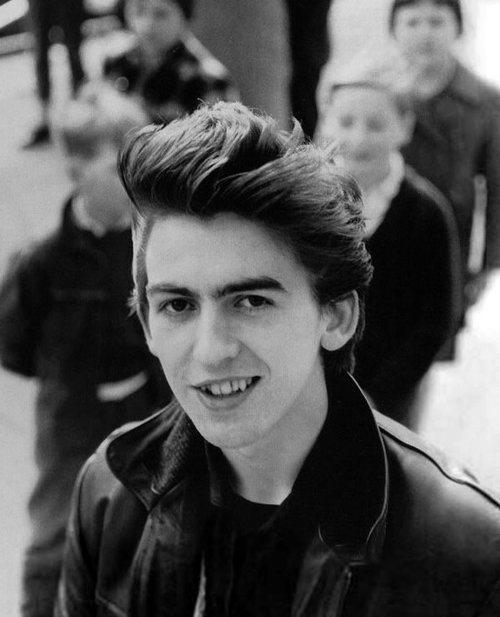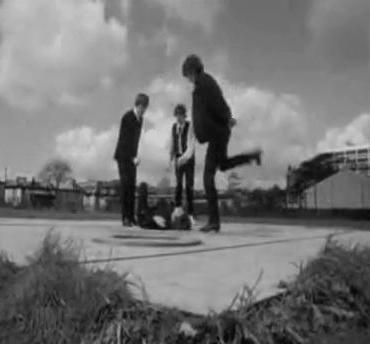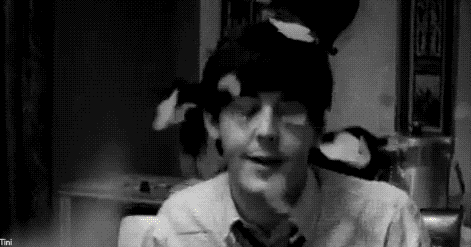
This post is inspired by a recent study that examined the use of pronouns in Beatles songs. Basically, the study concluded that the use of first person pronouns (I, me, etc.) dramatically declined as the band's career proceeded. The authors reasoned that this shift was due to a shift in substance from interpersonal relationships (boy meets girl, girl leaves boy, etc.) to more complicated narratives and political statements.
That seems reasonable enough to me, but I don't find it a particularly novel conclusion.
I'm more interested in how pronouns were used in unusual ways. It's easy enough to conclude from John's "I'm a Loser" that the loser is John himself. It's logical, and John has confirmed that it's true. But what about "Nowhere Man"? John has said that the song is about his insecurities during a rare unproductive writing session. If that's true, why would he write "he's a real nowhere man" and not "I'm a real nowhere man"? "I'm a Loser" shows us that John wasn't afraid to write highly personal songs in the first person, so why the shift to the third person?
As you've probably concluded if you've read my blog a bit, I like to answer such questions by categorizing relevant songs. What follows is a categorization of all of John's Beatles-era songs that we know are about him. I've categorized them based on the pronoun used to describe the song's protagonist.
It's important to note that I'm not including every song John wrote that has some sort of protagonist in it. Instead, I'm only including those songs that we know to be about John himself. For example, I'm including Help! because we know it describes John's struggles with low self-esteem in 1965, but not Misery because there's no indication he wrote it about himself, as opposed to a generic guy whose girl left him. As such, there's actually no song in here that was written before Beatles for Sale.
First Person
I'm a Loser (Beatles for Sale - 1964)
Help! (Help! - 1965)
Norwegian Wood (This Bird Has Flown) (Rubber Soul - 1965)
The Word (Rubber Soul - 1965)
In My Life (Rubber Soul - 1965)
I'm Only Sleeping (Revolver - 1966)
She Said She Said (Revolver - 1966)
Glass Onion (White Album - 1968)
I'm So Tired (White Album - 1968)
Julia (White Album - 1968)
Yer Blues (White Album - 1968)
Revolution 1 (White Album - 1968)
Across the Universe (Yellow Submarine - 1969)
Third Person
Nowhere Man (Rubber Soul - 1965)
Doctor Robert (Revolver - 1966)
Come Together (Abbey Road - 1969)
Second Person
You've Got to Hide Your Love Away (Help! - 1965)
That list is actually surprisingly short. Please let me know in the comments section if I've missed any song.
The most interesting songs are obviously those that use second or third person pronouns, so those are the songs we'll tackle here. The songs in the first category are certainly interesting, though, and could merit their own post.
In any case, let's start with the only one that uses the second person in the most prominent position in the narrative.
You've Got to Hide Your Love AwayYou've Got To Hide Your Love Away is usually thought to be about the affairs John was having at the time, so we could see the use of second person pronoun to be either a linguistic device meant to allow him to write about the affairs without making it obvious that he was having them, or it could serve as a warning to him to stop the affairs. I'm actually inclined to think it's the latter, because of the switch from first person to second person from the verse to the chorus:
Here I stand, head in hand
Turn my face to the wall
If she's gone, I can't go on
Feeling two foot small
Everywhere people stand
Each and every day
I can see them laugh at me
And I hear them say
Hey you've got to hide your love away
It seems to me that John is describing his shame at having the affair, and then using the crowd's judgment as a device for self-admonishment. If you want to get particularly metaphysical, you could also say that the crowd represents the materially/physically motivated part of his brain, which his conscious is warning against committing immoral acts. If you agree with this interpretation, then this song represents clear musical evidence that John regretted his infidelities.
In any case, let's move on to the three songs that use the third person most prominently.
Nowhere Man
Nowhere Man was supposedly borne from the rare unproductive writing session. John felt as though he couldn't write anything good, and ended up almost unconsciously writing Nowhere Man. As in You've Got to Hide Your Love Away, John uses the first (and second, in this case) person pronouns in a quite interesting way. Let's take a look:
He's a real nowhere man
Sitting in his nowhere land
Making all his nowhere plans, for nobody
Doesn't have a point of view
Knows not where he's going to
Isn't he a bit like you and me?
Nowhere man, please listen
You don't know what you're missing
Nowhere man, the world is at your command
He's as blind as he can be
Just sees what he wants to see
Nowhere man, can you see me at all?
Nowhere man, don't worry
Take your time don't hurry
Leave it all, til somebody else lends you a hand
At that point, the lyrics begin to repeat themselves. As in You've Got to Hide Your Love Away, it seems to me that John uses the three classes of pronouns to separate himself from one part of his conscious, and then speak to that part. In this case, he's separating himself from the part of his consciousness that is intensely insecure about the prospect that he might not be productive after all (the first two verses strongly suggest that).
The third and fifth stanzas use the second person pronoun in order to speak to the nowhere man and reassure him that he is actually something special (the world is at your command) and that he shouldn't worry. Perhaps he should even relax and allow himself to be vulnerable enough to ask for help (leave it all, til somebody else lends you a hand).
That seems evident enough to me. But the most confounding line is, "Isn't he a bit like you and me." With that line, the "you" could switch from the nowhere man to the audience. However, if we keep this song's universe as John's own mind, perhaps we have the following:
John realizes he is intensely insecure. He separates himself from that insecurity in order to examine it (he's a real nowhere man). He realizes that it's part of him (isn't he a bit like you and me?), and then begins to comfort himself and give himself advice (nowhere man, don't worry). So this song becomes essentially a self-administered therapy session.
Doctor Robert and Come Together
In the interest of not rambling on too much, I'm going to give these two tracks slightly more superficial treatments. Doctor Robert is supposedly about how John used to be the one to carry around and distribute the speed during the early days. It seems to me that he wrote about that through the alter ego of Doctor Robert simply to protect himself from scrutiny.
Come Together really should be its own post (perhaps I'll do that soon). There's controversy over whether this track includes cryptic references to each band member, is simply a sardonic self-portrait, or whether its both. In any case, it appears to me to simply be a slightly druggy, riddle-filled portrait of John's life at that time. "He shoot coca-cola" refers to John's cocaine use; "he got Ono sideboard" is obviously a reference to Yoko. As in the above songs, John appears again to talk to himself ("one thing I can tell you is you got to be free"). Perhaps that's John's advice to himself to spend time with Yoko without regard for the judgment of others.
But what about that chorus ("come together, right now, over me")? Given how druggy this song is, it might not mean anything at all. It could also refer to all the different parts of him (the cocaine use, his mojo ... everything "he got") coming together to form a cohesive conscious/identity that exists in his head, almost over his own material body.
So what can we conclude from this? It appears that John used second and third person pronouns in conjunction with first person pronouns when he wanted to speak to himself, and almost split up different parts of his identity/conscious. I'm sure that I've missed songs that could be relevant here (please let me know if you can think of any), but I've hopefully made my point clear.


























